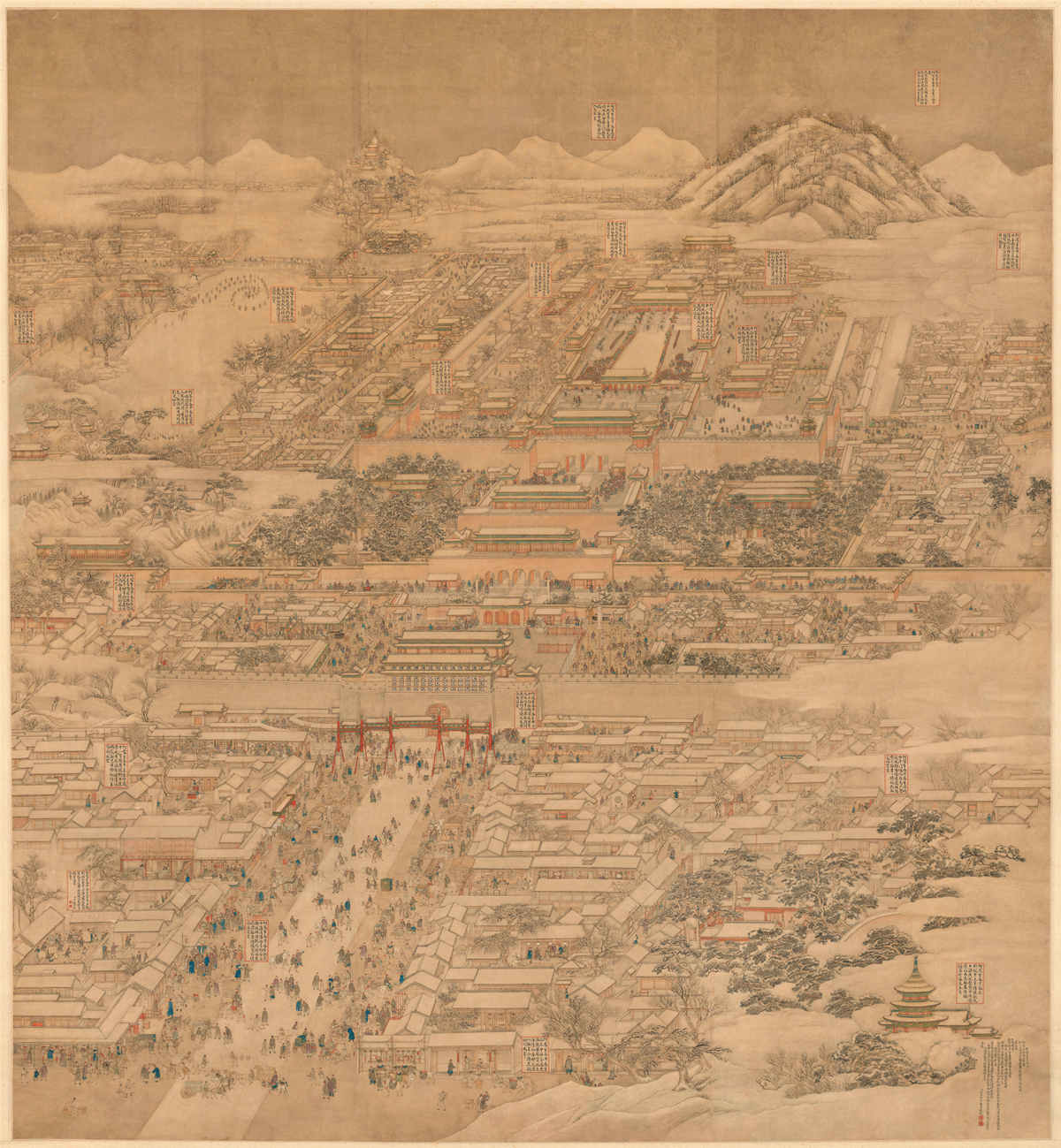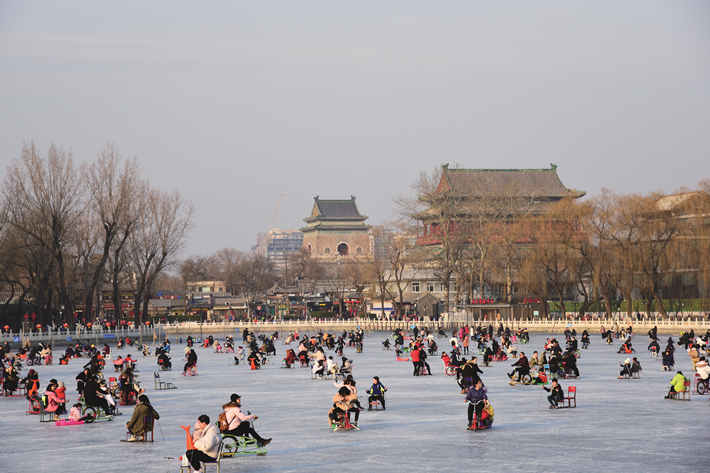Central Axis: The Backbone of Beijing

The city of Beijing in the Ming (1368-1644) and Qing (1644-1911) dynasties was the gem of all capitals throughout the history of ancient China. The city went through many ups and downs. Its construction began in the Ji state (c. 1300-1200 B.C.) during the Shang Dynasty (c. 1600-1046 B.C.), which became the capital of Jin (1115-1234) but was later captured by the Yuan army. That city site was just southwest of today’s Beijing until the winter capital Dadu was built in the Yuan Dynasty (1271-1368), when the old site was abandoned and a new site was selected in the northeast. This became the turning point of Beijing’s development.
Dadu was a typical traditional Chinese capital city in the farming civilization period. It pursued the ideal paradigm of a capital city described in Rites of Zhou in the Spring and Autumn Period (770-476 B.C.) and the Warring States Period (475-221 B.C.), yet followed a new system.
The Central Axis was determined based on the geographical conditions and layout of the city, and the entire city’s residential areas were distributed along intersecting north-south and east-west roads, like a chessboard. The layout remained the same in the Ming and Qing dynasties. In 1420, Emperor Yongle of the Ming Dynasty completed the construction of the imperial palace in Beijing, and then moved his capital to Beijing in the following year. The construction of the Ming capital, based on Dadu of the Yuan Dynasty, took 15 years. The renovation reflected the planning and designs of feudal emperors and laid the foundation for the scale and pattern of the old city of Beijing today.

A joyful crowd on the Shichahai Ice Rink. In the distance, the iconic Bell Tower and Drum Tower can be clearly seen on the northern part ofBeijing’s Central Axis. (Photo from VCG)
In the Ming Dynasty, the Forbidden City was designed for emperors to “hold court in the front and dwell in the back.” In the front are three main halls— the Hall of Supreme Harmony, the Hall of Central Harmony, and the Hall of Preserving Harmony. In the back are three inner palaces as well as six western palaces and six eastern palaces. Their arrangement and names all symbolize the sun, moon, and stars. Among them, the six main structures in the front and back of the Forbidden City occupy the most important positions on the Central Axis. In front of the Meridian Gate in the south of the Forbidden City, two sets of strictly symmetrical buildings, the Imperial Ancestral Temple and the Altar of Land and Grain, are arranged on both sides of the central road, highlighting the distinctiveness and prominence of the thoroughfare. Outside the Gate of Divine Prowess in the north of the Forbidden City is a man-made earth mountain named Prospect Hill (also known as “Coal Hill”). It is not only on the city’s Central Axis, but also lies in the exact middle of the north and south walls of the Inner City. This artificial high ground is the center of the old city of Beijing. One can look over the whole city from the top of the hill. It was significant for being a majestic entity that rests on a solemn and symmetrical plane, announcing itself as the center for the ruling feudal emperor.
In the southern outskirts of the old city, two groups of buildings were built on both sides of the Central Axis, namely the Temple of Heaven and the Altar of Mountains and Rivers (later renamed the Temple of Agriculture). The Temple of the Sun, the Temple of the Moon, and the Temple of the Earth were built in the east, west, and north, respectively. During the Jiajing reign (1507-1567) of the Ming Dynasty, the Outer City was built, enclosing the Temple of Heaven and the Altar of Mountains and Rivers inside its walls. The Yongding Gate, the southern gate of the Outer City, became a new south starting point for the Central Axis of Beijing. At the northern end of the Central Axis, the Bell Tower and the Drum Tower were built, thus forming a 7.8-kilometer Central Axis running through the Inner City and Outer City.
This is the longest central axis of a capital in China since the Qin Dynasty(221-207 B.C.). Like the backbone of a human being, it not only governs the balanced and symmetrical layout of the whole city of Beijing, but also highlights the ingenious planning and astute artistic instincts deployed in the feudal imperial capital to celebrate “the most honored in the world” to the greatest extent.

The Beijing Rickshaw Tour has become a popular activity among Chinese and foreign tourists.(Photo by Chen Fenglin)
“Beijing’s unique and magnificent order came about through the establishment of the Central Axis,” said famous Chinese architect Liang Sicheng. “Its symmetrical spatial distribution is all based on it. Its grandness is portrayed through the axis extending throughout the city.” To this day, visitors from all over the world praise Beijing’s urban design. Famous Danish architect and urban planner Steen Eiler Rasmussen once said, “The entire city of Beijing is one of the wonders of the world. Its layout is well-proportioned and clear. It is an outstanding monument symbolizing the pinnacle of a great civilization.” Edmund Bacon, an urban planner who once presided over the planning for the conservation of the ancient city of Philadelphia in the United States, said, “The layout design of old Beijing is so outstanding that it provides a rich source of ideas for cities today.”
After the founding of the People’s Republic of China in 1949, the renovation of Tiananmen Square highlights the inheritance and transformation of the old city of Beijing. After reconstruction, it now covers an area of 44 hectares and is the largest city square around the world.
Nowadays, a 1,600-meter section of the ancient Ming city wall is still preserved near the southeast corner tower of the Inner City of old Beijing. From the Wanchun Pavilion at the highest point of Jingshan Park, people can see the old city of Beijing radiating from the Forbidden City and guarded layer by layer. The grayish quadrangle residences rest in the shade, contrasting the resplendent Forbidden City. The Central Axis from the Yongding Gate to the Bell and Drum Towers is a great place to visit to appreciate the craftsmanship of the city. Tracing it will provide a deeper understanding of the importance of “protecting the old city of Beijing as a whole.” The old city is a carefully designed and magnificent area with great artistic value in every street and building.
The author is vice president and professor of the Geographical Society of China, and a distinguished expert of China Cultural Relics Academy.